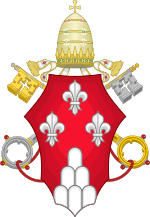Ecclesiam suam
| Ecclesiam suam (Latin: His Church) Encyclical Letter of Pope Paul VI  | ||||
|---|---|---|---|---|
| ||||
| Date | 6 August 1964 | |||
| Argument | The mandate of the Church in the Modern World | |||
| Encyclical number | 1 of 7 of the Pontificate | |||
| Text | in Latin in English | |||
Ecclesiam suam is an encyclical of Pope Paul VI on the Catholic Church given at St. Peter's, Rome, on the Feast of the Transfiguration, 6 August 1964, the second year of his Pontificate. It is considered an important document, which identified the Catholic Church with the Body of Christ. A later Council document Lumen gentium stated that the Church subsists in the Body of Christ, raising questions as to the difference between is and subsists in.
Pope Paul called the Church founded by Jesus Christ as a loving mother of all men.[1] In light of the ongoing Vatican Council he did not want to offer new insights or doctrinal definitions. He asked for a deeper self-knowledge, renewal and dialogue.[2] He also realized that the Church itself was engulfed and shaken by a tidal wave of change, and was deeply affected by the climate of the world.[3] He quotes the encyclical Mystici corporis of Pope Pius XII, as a key document: Consider, then, this splendid utterance of Our predecessor:
- "The doctrine of the Mystical Body of Christ, which is the Church, a doctrine revealed originally from the lips of the Redeemer Himself, and making manifest the inestimable boon of our most intimate union with so august a Head, has a surpassing splendor which commends it to the meditation of all who are moved by the divine Spirit, and with the light which it sheds on their minds, is a powerful stimulus to the salutary conduct which it enjoins." [4]
Paul VI considers Mystici Corporis, the doctrine of the Church as Mystical Body of Christ, timely and urgent and relevant to the needs of the Church in his day. A richer understanding of the Mystical Body, will result in a better view of its theological and spiritual significance.
This statement was important, when the Council defined the Church to subsist in the Body of Christ, rather than to be the Body of Christ, as Pius XII and all Popes before him had taught. A potential reversal of a vital teaching of the reigning Pope Paul VI, would have surely been noted inside and outside the Church at the time. Therefore, the phrase "subsists in" of Vatican II, is interpreted as not to undermine the identity of the "Church of Christ" and the "Catholic Church". John XXIII argued this point, when he opened Vatican II, "The Council … wishes to transmit Catholic doctrine, whole and entire, without alteration or deviation." Pope Paul VI, who in Ecclesiam suam had supported the interpretation of Pius XII, claimed also total identity of the old with the new: "There is no better comment to make than to say that this promulgation really changes nothing of the traditional doctrine.
- What Christ willed, we also will.
- What was, still is.
- What the Church has taught down through the centuries, we also teach." [5]
In Ecclesiam suam, Paul VI invited separated Churches to unity, stating that the continued papacy is essential for any unity, because without it, in the words of Jerome: "There would be as many schisms in the Church as there are priests." [6] In this encyclical, Paul VI attempted to present the Marian teachings of the Church in view of her new ecumenical orientation. Ecclesiam suam called the Virgin Mary the ideal of Christian perfection. Pope Paul VI regarded “devotion to the Mother of God as of paramount importance in living the life of the Gospel.” [7]
